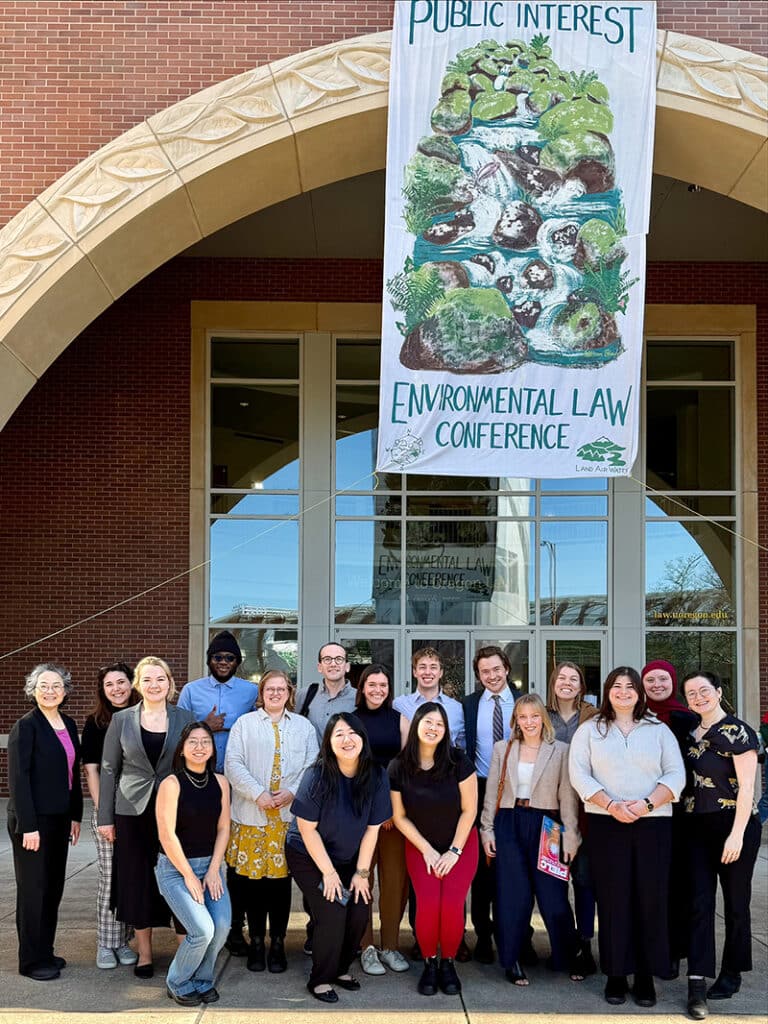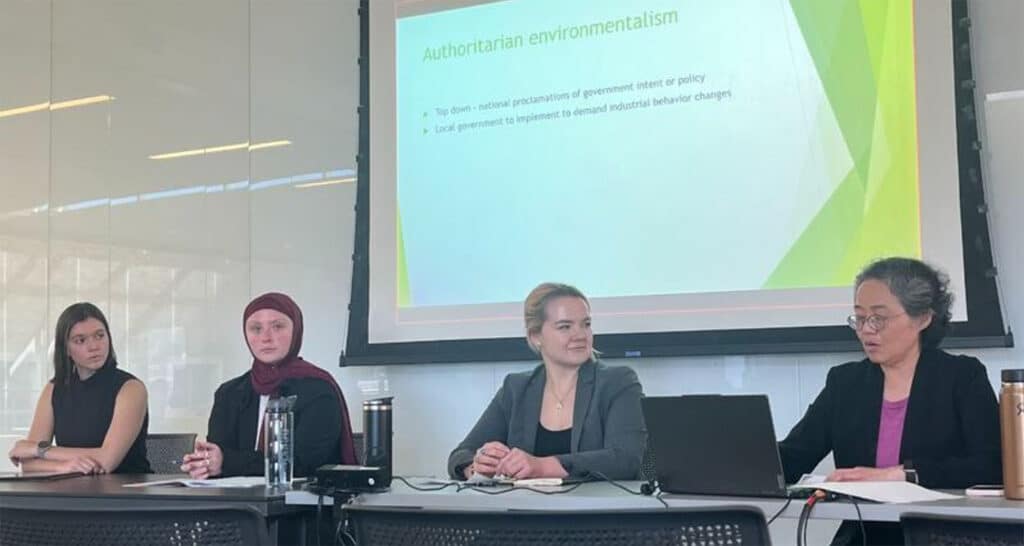In February, 14 Vermont Law and Graduate School students, along with four faculty and staff members, attended the 43rd Public Interest Environmental Law Conference (PIELC) hosted by the University of Oregon School of Law. VLGS also hosted a special Swan Reception on the first night of the conference, which provided the chance for students, faculty, and staff to mix with alumni, reconnect with friends, exchange insights, and expand their professional networks.
We are delighted to share reflections from three student participants—Matt Dederer JD/MELP’25, M. Christina Ramsey JD/MCEP’25, and Paige Wagar JD/MEM’27—as they joined activists, advocates, attorneys, scientists, and government officials for the oldest and largest public interest environmental law conference in the world.
Why did attending the Public Interest Environmental Law Conference interest you? In what ways did it complement the things you’ve discussed in class?
Matt Dederer (MD): “I believe climate change is the most pressing issue of our time. The decision to attend PIELC was easy, as I couldn’t pass up the opportunity to hear from and learn directly from leading advocates in the field. It provided a space to engage with practitioners working on some of the most urgent legal and policy challenges in environmental law today, from constitutional climate rights to agency deference and environmental justice. Overall, the panels provided concrete real-world examples that added depth and specificity to classroom discussions on administrative law and environmental justice.”
M. Christina Ramsey (MCR): “I wanted to see what discussions were happening within the climate governance and environmental justice space. As the world transitions to more sustainable practices, we must ensure that we are not simply copying and pasting the methodology of extractive economies. This conference was truly enlightening because I got to see many panels discussing this very topic, and I’m inspired to continue my work and research in this field.”
Paige Wagar (PW): “Attending PIELC was an incredible opportunity to connect directly with prominent legal scholars and practitioners in the specific fields I am interested in. I was also interested in attending PIELC because of the current administration’s hostility towards environmental protection and the federal workforce.

Before law school, I was a federal employee, and I fully intended to pursue a career in federal service after graduating. This summer, I was supposed to be a law clerk for the US Department of Justice’s Environment & Natural Resource Division, but my position was rescinded due to the federal hiring freeze. I wanted to go to PIELC to be in community with law students and lawyers who are committed to environmental protection in an era of unprecedented hostility to this field. We are not in an era of business as usual, and community-building is more necessary than ever before.”
What kinds of connections did you make with other attendees, panelists, and/or VLGS alumni?
MD: “At PIELC, I had the opportunity to engage with established practitioners and emerging voices in environmental law. A particularly impactful conversation was with John Bonine—professor at the University of Oregon School of Law, founder of PIELC, and founder of the Western Environmental Law Center—whose insights on public interest environmental litigation and his career journey were invaluable. I also had the chance to connect with law students from across the country, exchanging ideas about different approaches to environmental advocacy, as well as undergraduate students actively engaged in environmental policy work. These discussions reinforced the strength of the environmental law community and provided a broader perspective on how advocates are pursuing different legal and advocacy strategies nationwide.”
MCR: “I went to the Swan Reception event and got to meet alumni who work in various fields such as energy law and wildlife protection. It was really neat to hear all of the projects they are working on!”
PW: “At PIELC, I connected with fire ecologists, environmental activists, seasoned Indian law attorneys, and members of the public who are energized about public land protection. In particular, I connected with Natural Resources Defense Council staff, who I will be working with this upcoming summer in my position as a litigation intern. It was also a great opportunity to catch up with friends who are VLGS alums now practicing in Hawaii and Alaska!”
If you spoke at, contributed to, or attended any specific panels or events, can you talk about the topic(s) and how they enhanced your experience?
MD: “I attended various panels covering constitutional climate rights, Indigenous rights in the clean energy transition, and the future of environmental regulatory frameworks. A few particularly impactful sessions included ‘State Constitutional Green Amendments & Climate Rights,’ ‘Mineral Extraction & Indigenous Rights,’ and ‘The Impact of Loper Bright.’ Each panel broadened my understanding of legal and policy challenges in environmental law, reinforcing how advocacy and litigation must evolve to address emerging issues.”
MCR: “I joined Professor Siu Tip Lam, Advanced Student Clinician Ilinca Johnson JD’26 of the Transnational Environmental Law Clinic (TEL), and Mia Montoya Hammersley, director of the Environmental Justice Clinic, in presenting Environmental Justice and the Renewable Energy Transition at PIELC. Professor Lam discussed the different focus areas of the TEL and gave an overview of renewable energy and environmental projects in China. Ilinca reviewed her work under the TEL looking at Vermont and New York’s Climate Superfund Acts through a just transition analysis.

Professor Montoya Hammersley discussed environmental justice concerns that arise out of the ‘white gold rush’ towards electrification and why Tribes should be consulted. Finally, I presented on a paper I co-authored with Brett Francis JD/MCEP’25 that compared and contrasted just transition initiatives of coal-based industries within the United States and China. I was honored to present on this topic with my fellow panelists and enjoyed hearing more of their work!”
PW: “I prioritized attending Indian law and wildfire-related panels at PIELC, of which there were multiple. One panel that particularly stands out was co-hosted by Fire Generation Collaborative, Raincoast Conservation Foundation, and Earth Law Center. The US’s environmental ethic was built on colonial ideas centered on removing indigenous people from the land. As we look to the future, the environmental community needs to reckon with that history and listen to tribal communities about how they stewarded the land and what they need.”
What were the biggest takeaways from your experience at PIELC?
MD: “Two key themes stood out to me: determination and hope. Despite the challenges facing public interest environmental work, every person I interacted with at PIELC remained deeply committed to the fight. Rather than discouraging action, these hardships strengthened the resolve of advocates, attorneys, and organizers. The sheer number of attendees—many panels were so full that people had to sit on the floor—was a testament to the growing movement of legal professionals dedicated to environmental protection. Another major takeaway was the increasing importance of state-level legal strategies. As federal regulatory authority becomes more uncertain, cases like Held v. Montana and Navahine v. Hawaii DOT highlight how state constitutions and local governance can serve as powerful tools for climate and environmental justice.”
MCR: “The biggest takeaway that I have from this conference is that yes, the impacts of climate change are getting worse, and they are disproportionately affecting the most vulnerable. However, we have many legal and policy professionals within the public interest field working hard to ensure that we are responding in a sustainable and inclusive way.”
PW: “Attending PIELC affirmed my dedication to public service and using the law as a tool to promote responsible environmental stewardship. As a law student, it is easy to feel removed from the broader environmental movement. But PIELC energized my commitment to a legal career in environmental protection.”
Do you want to share any other observations, learnings, and/or impactful moments from your time at PIELC?
MD: “Beyond the substantive legal discussions, PIELC reinforced how critical it is to maintain both legal and non-legal grassroots advocacy efforts. Whether through strategic litigation, policy work, or direct community engagement, it’s clear that environmental law does not exist in a vacuum—it is deeply connected to social movements, economic justice, and public health.”
PW: “Lawyers hold immense power. And with that power, comes great responsibility. At PIELC, lawyers shared how they are using the law to protect people, culture, and place. Lawyers shared their successes in protecting sensitive landscapes, brainstormed sources of authority for expanded protection of tribal cultural sites, and more. It was energizing—and empowering—to hear all the ways lawyers are advocating for people and the land. PIELC was a chance to return to the reasons I came to law school and to contextualize my legal education within this political moment.”